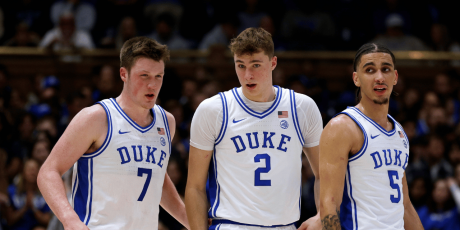What is Todd Gurley's Fantasy Value in Atlanta?

After releasing running back Devonta Freeman, the Falcons signed former Ram Todd Gurley to a one-year, $5 million contract. Gurley has been to three Pro Bowls and was a First-Team All-Pro in 2017 and 2018 but a chronic knee injury has led to a dip in production and fantasy value. The following will explore how Gurley’s move to Atlanta impacts his fantasy outlook for 2020.
Todd Gurley’s History
Since coming into the league in 2015, Gurley has been one of the most productive backs in the league. In that span, he leads all backs in touches, total yards and total touchdowns. That production also means a lot of wear and tear. The knee injury that made him virtually non-existent in the Rams’ 2018 playoff run makes many of Gurley’s past numbers a moot point. The 2019 season is the current baseline for Atlanta’s new back.
Last season, Gurley finished as the RB14 in half-PPR leagues but his stats were buoyed by a 14-touchdown campaign on 254 touches, a 5.5% touchdown rate. The league average rate for running backs last season was a score on 3.3% of touches and scoring tends to regress from season-to-season. While Gurley’s touchdown numbers are likely unsustainable, his volume and role should easily transfer to Atlanta.
How Todd Gurley Fits with the Falcons
In terms of running back usage, the move to Atlanta is a lateral one for Gurley. He goes from an offense that threw at the 13th-highest rate in neutral game script and ranked 30th in percentage of touches given to running backs, to a team that ranked third and 32nd, respectively, in the same categories. If Gurley can stay on the field for three downs, he may get a boost in passing-game work—Atlanta ranked 13th in targets to running backs last season while the Rams targeted their backs on the second-fewest passes in the league.
Speaking of being able to stay on the field, the perception that Gurley can no longer handle a significant workload may be somewhat overblown. He accounted for 68.5% of the Rams’ backfield touches in 2019, the ninth-highest rate in the league—Freeman’s 60.3% share ranked 13th last season. Since LA used their running backs so infrequently compared to the rest of the league, though, Gurley saw at least 15 touches in just nine games—19 backs had at least 10 such games—and hit the 20-touch mark just four times.
There is little to suggest that Gurley can’t inherit the 17.4 touches per game that Freeman leaves behind. Consider the Falcons’ 2019 touch distribution:
| Player | Pos | G | Touches | Touches/G | % of Team Touches |
|---|---|---|---|---|---|
| Devonta Freeman | RB | 14 | 243 | 17.4 | 29.7% |
| Julio Jones | WR | 15 | 101 | 6.7 | 12.4% |
| Brian Hill | RB | 12 | 88 | 7.3 | 10.8% |
| Austin Hooper | TE | 13 | 75 | 5.8 | 9.2% |
| Calvin Ridley | WR | 13 | 65 | 5.0 | 8.0% |
| Russell Gage | WR | 16 | 53 | 3.3 | 6.5% |
| Mohamed Sanu | WR | 7 | 35 | 5.0 | 4.3% |
| Matt Ryan | QB | 15 | 34 | 2.3 | 4.2% |
| Ito Smith | RB | 7 | 33 | 4.7 | 4.0% |
| Qadree Ollison | RB | 8 | 23 | 2.9 | 2.8% |
| Justin Hardy | WR | 16 | 19 | 1.2 | 2.3% |
| Kenjon Barner | RB | 14 | 10 | 0.7 | 1.2% |
| Christian Blake | WR | 7 | 9 | 1.3 | 1.1% |
| Jaeden Graham | TE | 15 | 9 | 0.6 | 1.1% |
| Luke Stocker | TE | 15 | 8 | 0.5 | 1.0% |
| Keith Smith | RB | 16 | 6 | 0.4 | 0.7% |
| Matt Schaub | QB | 11 | 3 | 0.3 | 0.4% |
| Olamide Zaccheaus | WR | 10 | 3 | 0.3 | 0.4% |
Going into 2019, there was some speculation that Ito Smith or Qadree Ollison could cut into Freeman’s workload but injuries to Smith and Ollison allowed Brian Hill to ascend to the RB2 spot in Atlanta. With the Falcons placing an original-round tender on Hill and the team possibly addressing the running back position in the draft, it’s unlikely that any back on the current roster cuts into Gurley’s work more than they did to Freeman last season.
After Freeman, the most notable departure from the Falcons’ offense is Austin Hooper, who leaves 75 touches vacated from last season. Atlanta did sign Hayden Hurst to replace Hooper, but the move is a clear downgrade at the position. While Hooper’s void could mean a bigger workload for Calvin Ridley or another pass-catcher, it may be an opportunity for Gurley to see an increased role in the short passing game.
One thing that this move doesn’t do is give Gurley much hope for a bump in terms of per-touch efficiency. His yards per carry were down last season compared to previous years but no Rams back bested Gurley’s 3.84 yards per attempt behind an offensive line that ranked 19th in adjusted line yards. Gurley will be running behind a Falcons line that ranked 24th in that category in 2019.
The Bottom Line
Todd Gurley’s move to Atlanta is an ideal situation given his injury and durability concerns. Even if he is asked to take on a vast majority of backfield work, the Falcons slant so heavily towards the pass that he won’t be asked to be a 20-touch per game player. Coming off of a season where he averaged 16.9 touches per game, Gurley should seamlessly transition to the 17.4 touches per game that Freeman leaves behind in Atlanta, especially if Gurley can improve on the 50 targets that he saw in 2019.
That workload would put Gurley in the middle of the fantasy RB2 conversation. Since free agency began, Gurley has been drafted as the RB16 in early best-ball drafts. Unless he has another outstanding touchdown rate, this price doesn’t give Gurley much room to outscore his ADP so I will be looking to draft him when he drops to the RB20 range in drafts, which should be the middle to late fourth round.






















